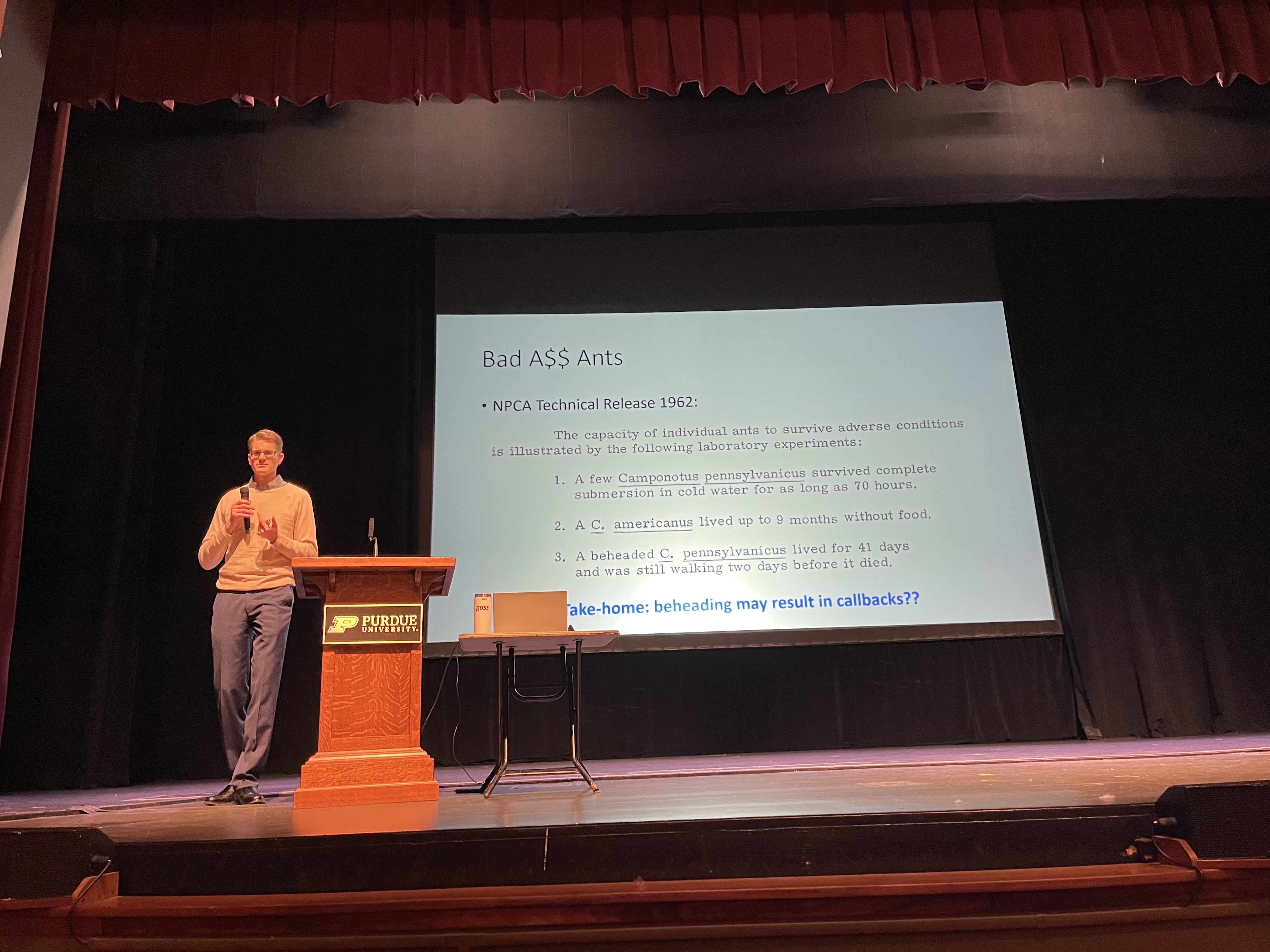
Amanda Joerndt
WEST LAFAYETTE, Ind. - It’s not too complicated here. Pinched waist with at least one node. Antennae elbowed, first segment generally longer than head. When present, hind wings are smaller than front.
That is what differentiates ants from other pests, Rose Pest Solutions Manager of Education and Training Mark VanderWerp said at this year’s Purdue Pest Management Conference in West Lafayette, Ind. It’s a colony of individuals working together collectively that makes ants, ants, Vanderwerp said.
“Is there such a thing as a single ant? No, there’s a colony associated with every ant that you see. It means there’s at least one colony present in the area.”
Many pests have broad dietary requirements, VanderWerp said. Almost any ant in urban situations loves to take nectar. Fruit trees are terrible for ant management. “The ants love to hit those peaches if you don’t go pick them first. Refined sugars like the infamous sugar dish, they’re into all of that,” he said. Those are common sources of carbohydrates; On top of that, there are myriad protein sources that may feed ants around our structures.
Removing, or reducing, alternative food sources and nest locations is key to enhanced treatment. Try to elevate to the point where you can find the worker ants, VanderWerp said.
“What [PMPs] are most used to is finding those trails of worker ants, slapping bait down and keep going,” he said. This works much of the time, but it’s always better for control when one knows where the colony is located and placing treatments as close to that as possible.
When we talk about repellency with ant control, it isn’t really repellency like we see with mosquito repellents; think instead about fast versus slow-working treatments, VanderWerp said. Fast treatments are aerosols, some sprayable pyrethroids and neonics. Slow working products include baits, IGRs, phenyl pyrazoles, and pyrroles. VanderWerp noted it’s okay to use some of each when treating. Fast treatments will shut down ant pheromone trails and slow options allow more material to get taken back to the colony with the ants.
“Let’s imagine the ant problem is inside a structure and you do a treatment around the outside. What do you think is going to happen? If it was repellent material, we should see more activity inside of the structure and less on the outside,” he said. “The homeowner can get upset because they think you pushed them inside.”

During the session “4x4 Ants” at the Purdue conference, VanderWerp reviewed four common structural ants PMPs treat in the field and four less common, or emerging ant pests. The less common ants covered were: Asian needle ants (Brachyponera chinensis), Pharaoh ants (Monomorium pharaonis), ghost ants (Tapinoma melanocephalum), and citronella ants (Lasius spp.).
Asian needle ants have been in the U.S. for 100 years but have only been making waves since the 2000s. They have a large, single, rounded node and are highly skewed toward feeding on protein-rich materials, like other insects.
Asian needle ants can sting, inflicting an anaphylactic reaction in some people, making them a medically important pest. They have smaller colony sizes along the East Coast and in some Midwest states. Granular baits are currently the best choice for management.
Pharaoh ants are tropically adapted, meaning they mainly infest buildings in the U.S. They build up large colony sizes and have multiple queens, making them difficult to control. Many industry reference books warn about their ability to split by budding if any liquid pesticides are used. VanderWerp argued this claim is likely overblown and shared some excerpts from literature showing that budding doesn’t always happen. Thinking about our treatments as fast and slow acting is a better approach. Baits are effective, but residuals can be used to discourage foraging to other, undesired food sources.
Ghost ants will nest anywhere and will feed on a wide variety of food items. They need to be in warm environments and in the North are often found in zoos and greenhouses.
There are a couple different species of citronella ants. They have a brighter yellow color, small eyes and are more or less subterranean ants. They have a single queen but can still exist in pretty massive colonies.
If you’re hunting for these ants, flip over a rock or dig around compost bins.
These ants rarely enter structures except when swarming events occur. However, during swarms hundreds or thousands of ants may enter a structure. Mechanical removal of swarmers and exclusion methods are the best approaches for managing these ants.
Latest from Pest Control Technology
- Donny Oswalt Shares What Makes Termites a 'Tricky' Pest
- Study Finds Fecal Tests Can Reveal Active Termite Infestations
- Peachtree Pest Control Partners with Local Nonprofits to Fight Food Insecurity
- Allergy Technologies, PHA Expand ATAHC Complete Program to Protect 8,500 Homes
- Housecall Pro Hosts '25 Winter Summit Featuring Mike Rowe
- Advanced Education
- Spotted Lanternflies, BMSBs Most Problematic Invasive Pests, Poll Finds
- Ecolab Acquires Guardian Pest Solutions





